欧莱雅五力模型分析
- 格式:ppt
- 大小:865.00 KB
- 文档页数:15
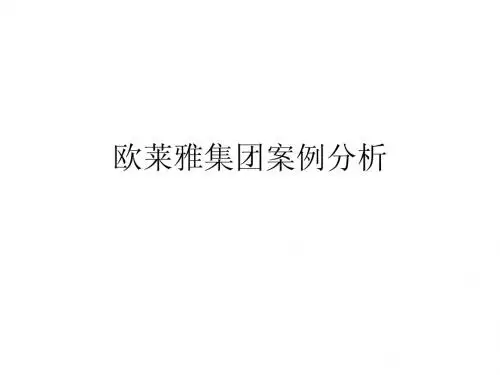
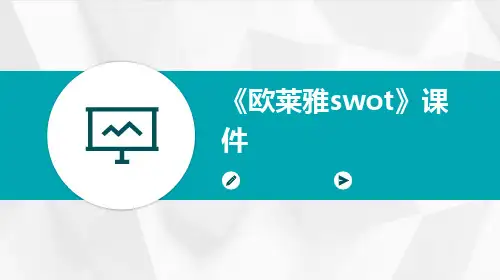
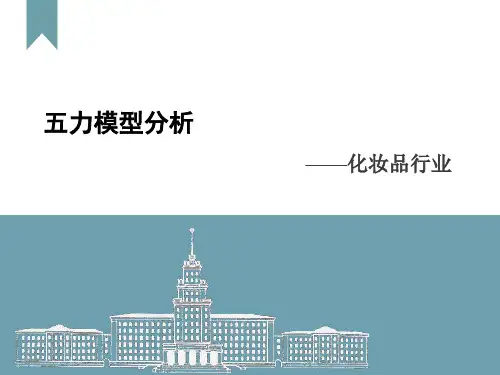
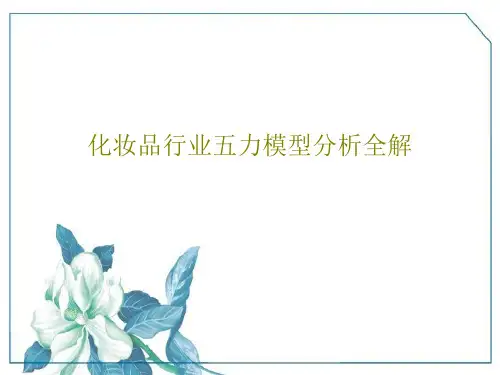
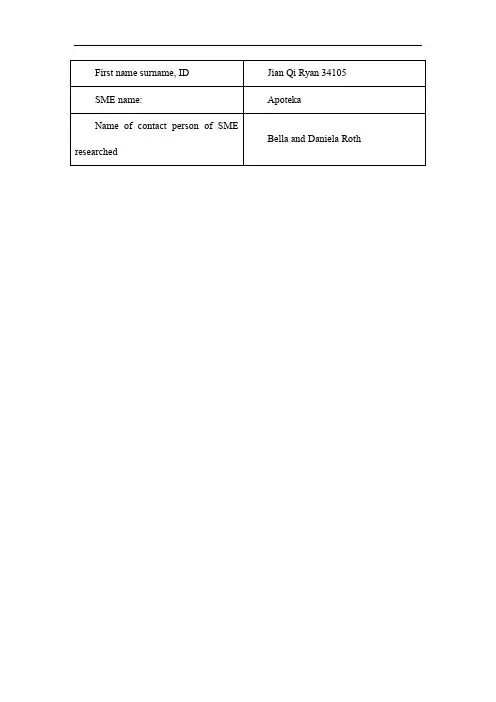
porter's five forces analysis供应商讨价还价能力供应商讨价还价能力较弱。
原料价格直接影响产品成本,外化妆品市场上存在着众多的供应商,供应量丰富,供应商之间竞争激烈且难以形成联盟,因此企业可较容易地获得这些原材料,无论是原料供应商还是销售渠道的供应商,其议价实力都较弱。
消费者讨价还价能力在化妆品市场上,由于化妆品品牌众多,竞争激烈,具备一定实力的经销商和终端卖场,尤其是连锁大型超市,具有很强的讨价还价能力,他们给化妆品企业施加巨大的压力,迫使厂家在保证质量的情况下让利。
而作为最终购买的消费者,获取信息的途径日益增多,国内品牌和国外品牌,普通化妆品和药妆,消费者拥有更多选择,议价能力较强。
替代者威胁消费者使用化妆品的目的主要是通过改善生理状况达到健康、美丽的效果。
虽然可以通过医学手段达到要求,但是这类替代品具有费用高、风险大等缺点,并不适合作为日常保养的手段。
其次,一些具有保健与养颜功效的药品、保健品对化妆品也有不同程度的替代作用,但消费者普遍认为这类产品的总体质量不高,另外普通化妆品也可作为药妆的强有力竞争者和替代品,但从长远来看,药妆取代普通化妆品的可能性很大。
新进入者的威胁药妆行业现在是化妆品业的一份蛋糕,加上体制不完善,进入门槛相对较低,新进入者十分多,但apoteka历史悠久,现作为龙头企业主导地位难撼动,因此具有竞争力的对手并不多,威胁不大。
行业内竞争药妆市场庞大的规模、巨大的增长潜力以及良好的开放程度,吸引了众多企业的进入,药妆品牌层出不穷,市场竞争愈演愈烈。
其中,欧莱雅、皮尔法伯等外资、合资企业现占据主导地位,而佰草集、本草堂、CE本草等国有企业也后劲正足,准备一展身手、抢滩市场,竞争激烈。
SwotStrengths产品多样化:在Apoteka的店里,你可以选购到大部分你所想得到的化妆或者个人护理用品。
对于那些不喜欢在商场里四处寻找商品的消费者来说是一个很好的去处。
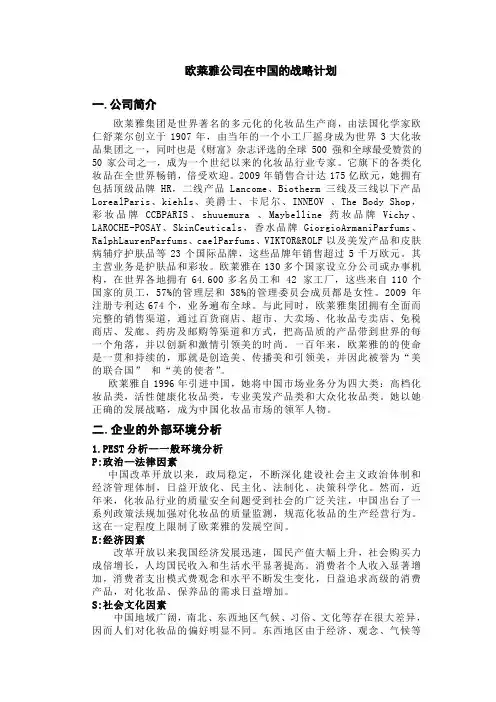
欧莱雅公司在中国的战略计划一.公司简介欧莱雅集团是世界著名的多元化的化妆品生产商,由法国化学家欧仁舒莱尔创立于1907年,由当年的一个小工厂摇身成为世界3大化妆品集团之一,同时也是《财富》杂志评选的全球500强和全球最受赞赏的50家公司之一,成为一个世纪以来的化妆品行业专家。
它旗下的各类化妆品在全世界畅销,倍受欢迎。
2009年销售合计达175亿欧元,她拥有包括顶级品牌HR,二线产品Lancome、Biotherm三线及三线以下产品LorealParis、kiehls、美爵士、卡尼尔、INNEOV 、The Body Shop,彩妆品牌CCBPARIS、shuuemura 、Maybelline药妆品牌Vichy、LAROCHE-POSAY、SkinCeuticals,香水品牌GiorgioArmaniParfums、RalphLaurenParfums、caelParfums、VIKTOR&ROLF以及美发产品和皮肤病辅疗护肤品等23个国际品牌,这些品牌年销售超过5千万欧元。
其主营业务是护肤品和彩妆。
欧莱雅在130多个国家设立分公司或办事机构,在世界各地拥有64.600多名员工和 42 家工厂,这些来自110个国家的员工,57%的管理层和38%的管理委员会成员都是女性。
2009年注册专利达674个,业务遍布全球。
与此同时,欧莱雅集团拥有全面而完整的销售渠道,通过百货商店、超市、大卖场、化妆品专卖店、免税商店、发廊、药房及邮购等渠道和方式,把高品质的产品带到世界的每一个角落,并以创新和激情引领美的时尚。
一百年来,欧莱雅的的使命是一贯和持续的,那就是创造美、传播美和引领美,并因此被誉为“美的联合国”和“美的使者”。
欧莱雅自1996年引进中国,她将中国市场业务分为四大类:高档化妆品类,活性健康化妆品类,专业美发产品类和大众化妆品类。
她以她正确的发展战略,成为中国化妆品市场的领军人物。
二.企业的外部环境分析1.PEST分析—一般环境分析P:政治—法律因素中国改革开放以来,政局稳定,不断深化建设社会主义政治体制和经济管理体制,日益开放化、民主化、法制化、决策科学化。
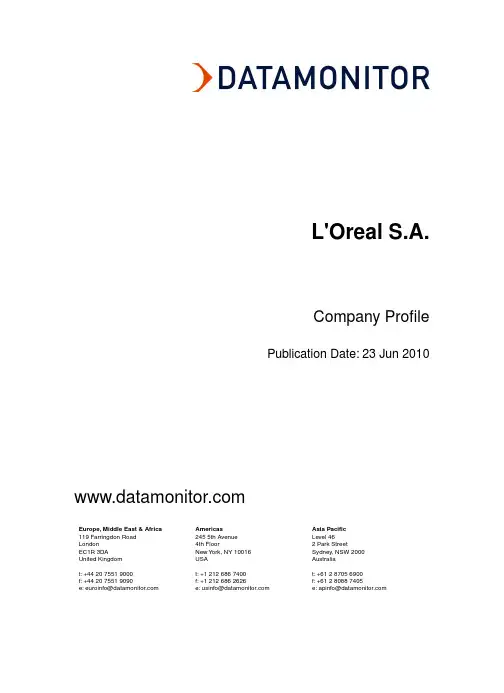
L'Oreal S.A.Company ProfilePublication Date: 23 Jun 2010AmericasEurope, Middle East & AfricaAsia Pacific245 5th Avenue119 Farringdon RoadLevel 46London4th Floor2 Park StreetEC1R 3DASydney, NSW 2000New Y ork, NY 10016United KingdomUSAAustraliat: +1 212 686 7400t: +44 20 7551 9000t: +61 2 8705 6900f: +1 212 686 2626f: +44 20 7551 9090f: +61 2 8088 7405e: euroinfo@e: apinfo@e: usinfo@ABOUT DATAMONITORDatamonitor is a leading business information company specializing in industry analysis.Through its proprietary databases and wealth of expertise, Datamonitor provides clients with unbiased expert analysis and in depth forecasts for six industry sectors: Healthcare, Technology, Automotive, Energy, Consumer Markets, and Financial Services.The company also advises clients on the impact that new technology and eCommerce will have on their businesses. Datamonitor maintains its headquarters in London, and regional offices in New Y ork, Frankfurt, and Hong Kong.The company serves the world's largest 5000 companies. Datamonitor's premium reports are based on primary research with industry panels and consumers. We gather information on market segmentation, market growth and pricing, competitors and products. Our experts then interpret this data to produce detailed forecasts and actionable recommendations, helping you create new business opportunities and ideas.Our series of company, industry and country profiles complements our premium products, providing top-level information on 10,000 companies, 2,500 industries and 50 countries.While they do not contain the highly detailed breakdowns found in premium reports, profiles give you the most important qualitative and quantitative summary information you need - including predictions and forecasts.All Rights Reserved.No part of this publication may be reproduced, stored in a retrieval system or transmitted in any form by any means, electronic, mechanical, photocopying, recording or otherwise, without the prior permission of the publisher, Datamonitor plc.The facts of this profile are believed to be correct at the time of publication but cannot be guaranteed. Please note that the findings, conclusions and recommendations that Datamonitor delivers will be based on information gathered in good faith from both primary and secondary sources, whose accuracy we are not always in a position to guarantee. As such Datamonitor can accept no liability whatever for actions taken based on any information that may subsequently prove to be incorrect.L'Oreal S.A.Page 2TABLE OF CONTENTSCompany Overview (4)Key Facts (4)SWOT Analysis.....................................................................................................5L'Oreal S.A.Page 3T ABLE OF CONTENTSCOMPANY OVERVIEWL'Oreal (or "the company") is one of the largest cosmetic companies in the world. It produces and markets a range of make-up, perfume, hair and skin care products in over 130 countries. It is headquartered in Clichy, France and employs 64,600 people.The company recorded revenues of E17,472.6 million ($24,367.8 million) during the financial year ended December 2009 (FY2009), a decrease of 0.4% compared with 2008.The operating profit of the company was E2,577.6 million ($3,594.8 million) in FY2009, a decrease of 5.4% compared with 2008.The net profit was E1,792.2 million ($2,499.5 million) in FY2009, a decrease of 8% compared with 2008.KEY FACTSL'Oreal S.A.Head Office 41 rue Martre92117 ClichyFRA33 1 47 56 70 00Phone 33 1 47 56 86 42Fax Web Address17,472.6Revenue / turnover (EUR Mn)December Financial Year End64,600EmployeesOR.PANYSE EuronextTicker L'Oreal S.A.Page 4Company OverviewSWOT ANAL YSISL'Oreal is one of the largest cosmetics companies in the world. Since its inception about 100 years ago, the company has developed a strong brand portfolio of 23 international brands.These brands are available through a range of distribution channels ranging from mass market, to selective distribution including hair salons, pharmacies/drugstores and a network of directly owned stores and franchises. Strong brand portfolio lends better visibility and presence in all distribution channels and enables L’Oreal to reach a large customer base, thereby increasing its market penetration opportunities. However, widespread counterfeits not only deprive revenues for the company but also dilute its brand image.WeaknessesStrengthsHeavily dependent on third party retailersLeading cosmetic company with portfolio ofstrong international brands and presence in all distribution channels Destocking of luxury products as the consumer preference shifts to value productsAccelerating globalization andinternationalization of the brand portfolioFocus on innovation and differentiationthrough robust R&D effortsThreatsOpportunitiesGrowing counterfeit goods marketFocus on niche segments—anti-ageing,men and organic products Tightening consumer spending on luxurygoodsGrowing presence in emerging marketsIncreasing competitionAcquisition of professional productdistributors in the USStrengthsLeading cosmetic company with portfolio of strong international brands and presence in all distribution channelsWith revenues of approximately E17.5 billion ($24.4 billion), L’Oreal is the world’s leading cosmetics group. Since its inception about 100 years ago, the company has developed a strong brand portfolio of 23 international brands. Its brand line-up includes L’Oreal, Redken, Matrix, Lancome, Body Shop, Garnier, Maybelline, Kerastase and inneov among others, all of which are recognized globally.These brands are available through a range of distribution channels ranging from mass market, to selective distribution including hair salons, pharmacies/drugstores and a network of directly owned stores and franchises. For instance, L’Oreal’s Professional Products Division distributes its products in hairL'Oreal S.A.Page 5salons all over the world.The Consumer Products Division offers products at accessible prices in all mass-market retailing channels (hypermarkets, supermarkets and drugstores.The Luxury Products Division brands are sold through selective distribution not only in department stores, perfumeries, and travel retail outlets, but also in free standing stores and through e-commerce websites.The Active Cosmetics Division distributes its products worldwide in all types of health channels, primarily through pharmacies, drugstores and medi-spas. L’Oreal’s Body Shop operates a network of 2,550 stores in 63 countries. Market leadership would not only provide a competitive advantage to the company but also enhance its bargaining power. Strong brand portfolio lends better visibility and presence in all distribution channels and enables L’Oreal to reach a large customer base thereby increasing its market penetration opportunities.Accelerating globalization and internationalization of the brand portfolioL’Oreal has been expanding geographically and capturing large markets.The company currently has operations in over 130 countries across all continents.The company has established strong presence in developed markets such as Europe and the US and is rapidly expanding into emerging economies of Asia, which provide a huge potential market. In addition, L’Oreal focuses on internationalization—buying local brands and gradually making them international, e.g. Matrix (the US), Maybelline (the US) and Shu Uemura (Japan).The company’s Matrix brand, which was primarily American (90% of sales) when L’Oréal acquired it in 2000, is currently present in more than 260,000 salons, more than one third of which are outside the US. L’Oreal’s presence in several geographical regions ensures a diversified revenue stream and reduces the business risk.The company is less vulnerable to the vagaries of a single economy.The internationalization strategy on the other hand allows the company to tap growth potential in other markets.Focus on innovation and differentiation through robust R&D effortsL’Oreal’s drive to innovate is based on a strong R&D effort.The company has devoted a minimum of 3.3% of sales to R&D since 2005, which is a much higher proportion than those invested by its main rivals (2.5% for Beiersdorf and 1% for Estee Lauder in 2008). R&D spending increased to a record 3.5% of sales in 2009.The company's research and development group comprises departments specialized in the technologies critical to the company's various product categories. The company has a cross-functional product development process intended to optimize the company's ability to bring to market its new product offerings and to ensure that the company continuously have new products lined-up in key categories under its various brands.Furthermore, L'Oreal has increased its focus on developing differentiated and customized products across various countries and regions. In order to understand local characteristics the company has research centers both in mature countries (11 in France, three in the US) and emerging markets (three in Asia and one in Brazil, opened in 2008).These R&D centers formulate products that are most effective and the best suited to the needs of the consumers in these countries and regions. For instance, in China, at the Pudong research centre, three years of study of Chinese hair, together with analysis and interpretation of a local custom using dry wash shampoo led to the creation of a range of shampoos and haircare products ideally suited to local hair types and cultural traditions, focusing on fragrance, gloss and the shine effect. In India, the company launched Fructis Fall Fight, L'Oreal S.A.Page 6a shampoo that helps prevent hair loss due to breakage that occurs with the very long, brittle hair of Indian women, and Shampoo+Oil 2 in 1, in a market where hair oil is an essential traditional beauty ritual. Strong R&D capability allows the company to launch new products frequently and also expand its presence in new markets.WeaknessesHeavily dependent on third party retailersL’Oreal uses independent distribution channels to sell its products, except for a limited number of stores (Kiehl’s, Lancome, Biotherm, The Body Shop and Shu Uemura) which are owned by the company.The company is therefore heavily dependent on third party retailers. As a result, L’Oreal has less control over brand image, consumer trends and advice given to customers and limited room for manoeuvre in case of inventory rundowns. Over-reliance on third party retailers makes the company prone to top-line risks from external parties.Destocking of luxury products as the consumer preference shifts to value productsL’Oreal’s luxury division is affected adversely as the consumers are trading down amid the global economic uncertainty.The luxury market has been witnessing slow down in several markets and there has been a shift of consumer preference towards value retailing. Luxury markets previously had a large potential market as there was a large aspiring customer base that would transition to the luxury products.The economic slowdown across the world has impacted this pool of aspiring customers as the discretionary spending has been affected negatively and the consumer spending is expected to be depressed for some time now.This has lead to substantial destocking of the company’s luxury cosmetic products at retailers in Europe and the US. Such destocking by the retailers would impact L’Oreal’s top line growth adversely.OpportunitiesFocus on niche segments like anti-ageing, men and organic productsProducts in the anti-ageing, men’s care, and organic and natural segments are all expected to boost growth in mature markets as well as developing countries.The proportion of the population aged over 60 is expected to increase in most countries and particularly in Asia (an estimated 23% in China in 2025 versus 12% in 2005). Moreover, this age bracket buys the most cosmetics and has a much higher annual budget than customers in younger age brackets. L’Oréal is taking advantage of the momentum in this segment by producing anti-ageing products for several categories (hair care and facial skincare) and portfolio brands (Kerastase, L’Oreal Paris and Lancome). For instance, Lancome has launched a treatment called Renergie Lift Volumetry which firms up tissues and L’Oreal Paris has launched Code Jeunesse, a new range of anti-ageing products.L'Oreal S.A.Page 7The market for men’s care products increased roughly twice as much as the global cosmetics market. The market is valued at $19.7 billion worldwide in 2009; male-specific grooming products are estimated to constitute $28.0 billion by 2014. Additionally, men also use grooming products that arenon-male-specific. Combining this, the total value of male consumption is at $61.3 billion in 2009, and the market is expected to reach $84.9 billion in five years. Men are spending more on grooming and the factors that contributed to the growth are the rise of the middle-class sector; the enhanced connectivity of even the poorest corners of the world, via the Internet and marketers’ more sophisticated appeals to men. L’Oreal Men Expert is the leading men’s facial skincare product. In addition, the company’s Biotherm is the world leader in men’s care products in selective channels. The global natural & organic personal care (N&OPC) and household product sales totaled $27 billion in 2008, an increase of 11.5% over 2007.The US is the biggest market for N&OPC products constituting 37% of the total market. Japan with 12% share is the second largest national contributor and the market is valued at $3.3 billion. China and the rest of Asia represent about 15% of the global N&OPC market, with the total market value at $4.3 billion. L’Oreal’s Body Shop operates a chain of cosmetic stores specializing in skin and hair care products made from natural ingredients. In addition, L’Oreal’s other products with natural ingredients include Garnier’s latest HerbaShine Color cream with bamboo extracts, L’Oreal Professionel’s ammonia-free colorant Inoa, and Kiehl’s organic product line named Acai. Focusing on niche segments which offer a great potential would provide steady revenues for the company in near term.Growing presence in emerging marketsThe worldwide cosmetics market is expressing interest in participating in the emerging economies. By 2020, countries in the Rest of the World zone (countries excluding North America, Western Europe and Japan) may represent more than 50% of the total cosmetics market. People living in emerging countries consume on average 10 times fewer cosmetics products than those in developed countries.With a constantly growing GDP, this level should increase very quickly. Furthermore, the emergence of new markets such as China, India and Brazil, opens up a significant growth opportunity for the company. For instance, the Chinese cosmetics market is the fourth-largest in the world and is set to grow by 13% per annum till 2012. L’Oreal’s exposure to emerging markets has increased significantly.The share of emerging markets in the company’s sales has doubled every 10 years, reaching 33% in 2009, and it will probably represent more than half of the company’s sales within the next 10 years. L’Oreal’s strong presence in growing markets augurs well for revenue base of the company in the long term.Acquisition of professional product distributors in the USL’Oreal adopts a specific strategy in the US based on buying successive local professional product distributors in order to access hair salons. In line with this strategy, the company bought Beauty Alliance and Maly’s West in 2007, Columbia Beauty Supply in 2008. Most recently, in June 2009, the company acquired Idaho Barber and Beauty Supply (IBB), a distributor of professional products to hair salons in several states in the North West of the US, particularly Idaho, Montana and Washington. Later in December 2009, the company acquired Maly's Midwest and Marshall Salon Services which together supply over 40,000 hair salons across eight states in the Middle West with L'Oreal S.A.Page 8a network of 120 representatives and 90 stores.With these acquisitions, L’Oréal has expanded its reach across 80% of the US (50% at the end of 2008). Initiatives such as these would expand the company‘s coverage of American hair salons and in turn impact its topline.ThreatsGrowing counterfeit goods marketThe counterfeit products market has been growing in the recent years driven by the internet counterfeit market.The abundance of counterfeit goods and accessories is adversely affecting the sales of branded products. It is estimated that the loss due to counterfeit products convert into around E6 billion ($8.5 billion).With the advent of digital channels there has been a surge in the sale of counterfeit products and online sales of these products increased by 9% in 2009. In November 2009, the US Immigration and Customs Enforcement (ICE) agents seized more than 17,000 counterfeit items worth an estimated $643,000 from 21 businesses in the Minneapolis-Saint Paul twin cities region in the US and the consignment included 3,524 bottles of perfume. Geographically, over half of the fake goods confiscated at EU borders came from China.The personal care category is among those that recorded the highest increases in registered IPR infringement cases. Low quality counterfeits reduce consumer confidence in branded products. Also, what differentiates the offerings of companies such as L’Oreal from its competitors is exclusivity; widespread counterfeits reduce this exclusivity. Counterfeits not only deprive revenues for the company but also dilute its brand image. Tightening consumer spending on luxury goodsThe current economic slowdown has resulted in lower consumer confidence and lower retail sales which has affected the company’s net sales and profitability. Due to the tightening consumer spending, the luxury market is further expected to witness sharp fall in the growth rates especially in developed economies.The global luxury market is estimated to have fallen by 6% in 2009. L’Oreal’s Luxury Products division was hit the hardest by these conditions and the division’s like-for-like sales fell 9% in FY2009.The sales in the US, Japan and Europe are estimated to be down by 16%, 10% and 8% respectively in 2010. Although, the global luxury market is estimated to record a slight growth of 1% in 2010 buoyed by the growth in emerging economies, the market will not recover to pre-recession 2007 levels until 2012. Such adverse trends indicate a tough macro-economic environment which can further impact the sales of L’Oreal’s luxury product division.Increasing competitionThe skin care, makeup, fragrance and hair care businesses are characterized by intense competition throughout the world.The company competes in selected product categories against a number of multinational manufacturers. In addition to products sold in the mass-market anddemonstrator-assisted channels, the company's products also compete with similar products sold in prestigious department store channels, through door-to-door sales, through mail-order or telemarketing by representatives of direct sales companies. Brand recognition, quality, performance L'Oreal S.A.Page 9and price have a significant influence on consumers' choices among competing products and brands. Advertising, promotion, merchandising, the pace and timing of new product introductions, line extensions and the quality of in-store sales staff also have a significant impact on consumers' buying decisions. L'Oreal's major competitors include Revlon, Unilever, Procter & Gamble, Avon, Shisiedo, and Estee Lauder. In addition, many luxury brands, in both the ready-to-wear and jewellery segments, are diversifying in cosmetics or will do so in the future. For instance, Van Cleef & Arpels in March 2010 launched a women’s fragrance called Oriens with InterParfums. Increasing competition could adversely affect the company's margins.L'Oreal S.A.Page 10Copyright of L'Oreal SA SWOT Analysis is the property of Datamonitor Plc and its content may not be copied or emailed to multiple sites or posted to a listserv without the copyright holder's express written permission. However, users may print, download, or email articles for individual use.。
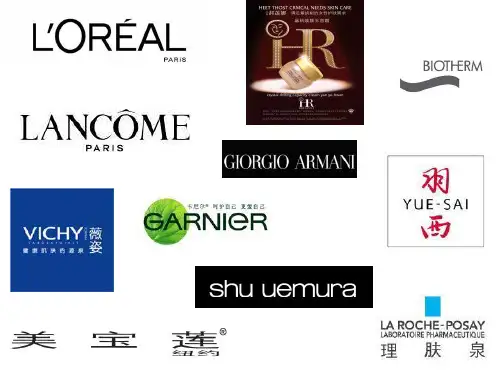
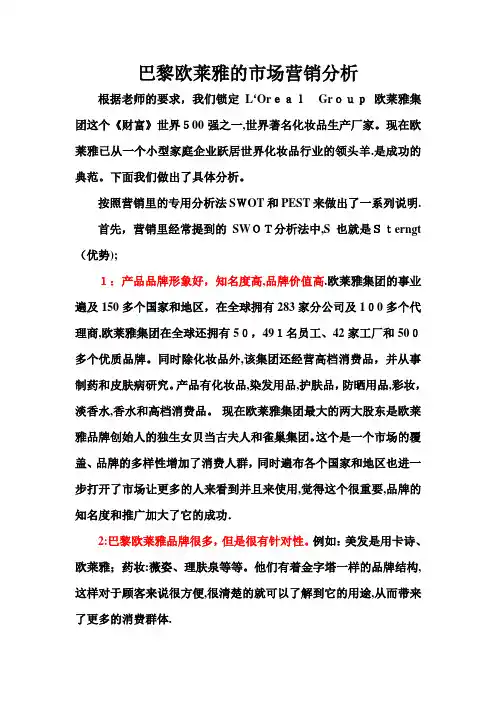
巴黎欧莱雅的市场营销分析根据老师的要求,我们锁定L‘OrealGroup欧莱雅集团这个《财富》世界500强之一,世界著名化妆品生产厂家。
现在欧莱雅已从一个小型家庭企业跃居世界化妆品行业的领头羊.是成功的典范。
下面我们做出了具体分析。
按照营销里的专用分析法SWOT和PEST来做出了一系列说明.首先,营销里经常提到的SWOT分析法中,S也就是Sterngt (优势);1:产品品牌形象好,知名度高,品牌价值高.欧莱雅集团的事业遍及150多个国家和地区,在全球拥有283家分公司及100多个代理商,欧莱雅集团在全球还拥有50,491名员工、42家工厂和500多个优质品牌。
同时除化妆品外,该集团还经营高档消费品,并从事制药和皮肤病研究。
产品有化妆品,染发用品,护肤品,防晒用品,彩妆,淡香水,香水和高档消费品。
现在欧莱雅集团最大的两大股东是欧莱雅品牌创始人的独生女贝当古夫人和雀巢集团。
这个是一个市场的覆盖、品牌的多样性增加了消费人群,同时遍布各个国家和地区也进一步打开了市场让更多的人来看到并且来使用,觉得这个很重要,品牌的知名度和推广加大了它的成功.2:巴黎欧莱雅品牌很多,但是很有针对性。
例如:美发是用卡诗、欧莱雅;药妆:薇姿、理肤泉等等。
他们有着金字塔一样的品牌结构,这样对于顾客来说很方便,很清楚的就可以了解到它的用途,从而带来了更多的消费群体.3:产品的质量和研发技能强。
从它的产品的质量、功能、款式、品牌、包装那又是一大卖点;价格适中;好的广告宣传;利用新闻宣传媒体的力量;和政府建立良好关系;建立合适的销售渠道。
其竞争的主要优势集中在产品的研发上,对于欧莱雅集团建立了自己的研发中心,其研发能力一直保持领先的地位.4:客户管理及服务质量好。
欧莱雅在日化行业中高档市场中处于领导地位.它不但拥有大量的消费群体,而且在服务方面积累了丰富的经验,尤其在专柜服务质量方面想象好,覆盖面广,为消费者接收到优质的服务提供了很好的硬件支持。
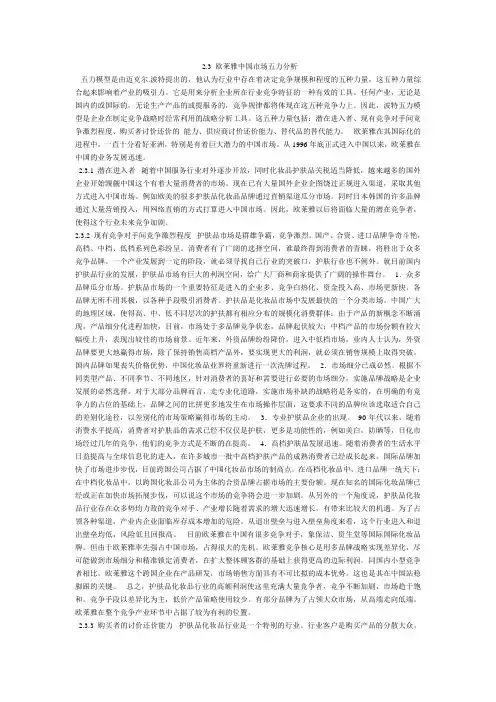
2.3 欧莱雅中国市场五力分析五力模型是由迈克尔.波特提出的,他认为行业中存在着决定竞争规模和程度的五种力量,这五种力量综合起来影响着产业的吸引力。
它是用来分析企业所在行业竞争特征的一种有效的工具。
任何产业,无论是国内的或国际的,无论生产产品的或提服务的,竞争规律都将体现在这五种竞争力上。
因此,波特五力模型是企业在制定竞争战略时经常利用的战略分析工具。
这五种力量包括:潜在进入者、现有竞争对手间竞争激烈程度、购买者讨价还价的能力、供应商讨价还价能力、替代品的替代能力。
欧莱雅在其国际化的进程中,一直十分看好亚洲,特别是有着巨大潜力的中国市场。
从1996年底正式进入中国以来,欧莱雅在中国的业务发展迅速。
2.3.1 潜在进入者 随着中国服务行业对外逐步开放,同时化妆品护肤品关税适当降低,越来越多的国外企业开始觊觎中国这个有着大量消费者的市场。
现在已有大量国外企业企图饶过正规进入渠道,采取其他方式进入中国市场。
例如欧美的很多护肤品化妆品品牌通过直销渠道瓜分市场。
同时日本韩国的许多品牌通过大量营销投入,用网络直销的方式打算进入中国市场。
因此,欧莱雅以后将面临大量的潜在竞争者,使得这个行业未来竞争加剧。
2.3.2 现有竞争对手间竞争激烈程度 护肤品市场是群雄争霸,竞争激烈。
国产、合资、进口品牌争奇斗艳,高档、中档、低档系列色彩纷呈。
消费者有了广阔的选择空间,谁最终得到消费者的青睐,将胜出于众多竞争品牌。
一个产业发展到一定的阶段,就必须寻找自己行业的突破口,护肤行业也不例外。
就目前国内护肤品行业的发展,护肤品市场有巨大的利润空间,给广大厂商和商家提供了广阔的操作舞台。
1.众多品牌瓜分市场。
护肤品市场的一个重要特征是进入的企业多、竞争白热化、资金投入高、市场更新快。
各品牌无所不用其极,以各种手段吸引消费者。
护扶品是化妆品市场中发展最快的一个分类市场。
中国广大的地理区域,使得高、中、低不同层次的护扶都有相应分布的规模化消费群体;由于产品的新概念不断涌现,产品细分化进程加快,目前,市场处于多品牌竞争状态,品牌起伏较大;中档产品的市场份额有较大幅度上升,表现出较佳的市场前景。

分析化妆品行业销售情况通过学习迈克尔波特的五力模型,使我对企业中决定竞争规模和程度的五种力量有了初步的认识,利用这种有效的工具,现将化妆品的竞争特征进行一下简单的分析。
1、新进入者威胁近年来,随着城市消费水平的不断提升,越来越多的进口品牌将战略眼光转向二线城市,迪奥、雅诗兰黛、兰蔻、资生堂等世界知名品牌,凭借自身的产品优势及品牌效应,市场便掀起了一股“世界风”。
同时,一些多元化经营的企业将目光投向化妆品行业,一些新兴的品牌也如雨后春笋般遍地开花,对于这些新进入者来说,三级市场的分销渠道获取相对容易,虽然网点质量一般,但相对于进入一二级市场的难度及各种居高不下的费用,进入小城市便成为一个很好的选择和机遇。
2、现有企业竞争伴随着进口品的入驻,其它店的化妆品牌结构更加合理,对我们就有着很大的冲击,加上各种日化专卖店、美容护肤店日益增多,网上商城也日渐成熟,带来的竞争激烈程度可窥一斑。
化妆品行业市场集中度相对较低,很多竞争对手实力相当,强化了对抗程度,使化妆品的销售环境更加恶劣。
3、替代品威胁化妆品主要起保养、淡化、修复等功能,想得到明显改善就需要使用相当长的时间,这与药品的功效性与即时性相比较无疑是一个软肋,而药品成为替代品似乎会是一种必然。
另外,一些辅助美容器械,如前几年热销的“再清椿”美容面具等,随着科学技术的日新月异,通过器械来改善皮肤的外观可能很快就成为一种现实。
4、供应商的议价能力在我们商场里,一些大品牌做活动就必须给予这样那样的支持,否则活动无法开展,经理为了提升销售业绩争取到品牌更大的优惠,也不得不尽量满足这些要求,但同时利润方面就有了较大损失。
这些有优势的供应商不断地加强讨价还价能力,也给日常销售工作带来一定的压力。
5、购买者的议价能力顾客是企业产品或服务的购买者,是我们的“上帝”。
为了更好地吸引顾客,我们不断地推出优惠活动,久而久之,精明的顾客们往往等待下一次更大的活动来购买,或者在赠品方面要求更多。
我国化妆品行业竞争分析——五力模型依照迈克尔・波特的观点,一个行业的激烈竞争不是事物的巧合,其根源在于内在的经济结构。
如图所示,一个行业中的竞争,远不止在原有竞争对手中进行,而是存在着五种基本的竞争力量,即行业内现有企业之间的竞争、潜在进入者、替代品生产者的威胁、买方议价能力以及供方议价能力。
这些因素的状况及其综合强度,决定着行业竞争的激烈程度和获得利润的最终潜力。
1.1 潜在进入者的威胁总的来说,整个化妆品行业存在着市场细分明显、产品多样化等特点,且进入化妆品市场的设备投资、技术含量、员工培训等要求并不高,因此,潜在进入者的进入壁垒相对于其他行业来说较低。
然而,许多因素正在逐步提高潜在进入者的进入壁垒。
首先,近年来随着中国化妆品行业的快速发展,政府部门已经从不同角度加强了对化妆品的管制,逐步完善了化妆品管理的法规体系,这在一定程度上提高了潜在进入者的门槛。
其次,对于大多数潜在进入者来说,最大的进入障碍是能否顺利获得分销渠道。
再次,产品的差异化也是化妆品行业的主要进入壁垒之一。
顾客忠诚度是消费者购买行为的主要特性之一,而产品的差异化是构成顾客忠诚度的基础。
现有的一些知名品牌,如:欧莱雅、玉兰油、资生堂、欧泊莱、美宝莲等,经过多年经营,已经形成了相对稳定的消费群体。
当消费者习惯于使用某种产品时,要消除这种忠诚度就必须耗费大量的财力物力。
1.2 行业内现有企业间的竞争行业内现有企业间的竞争多采用的竞争手段主要有价格战、广告战、引进产品以及增加对消费者的服务等。
竞争的产生是由于一个或多个竞争者感受到了竞争的压力或看到了改善其市场地位的机会。
中国化妆品市场庞大的规模、巨大的增长潜力以及良好的开放程度,吸引了众多企业的进入,化妆品品牌层出不穷,市场竞争愈演愈烈。
截至2006年底,全国共有化妆品生产企业3804家,主要分布在我国沿海省份,以珠江三角洲、长江三角洲和环渤海经济带最为集中。
其中,宝洁、欧莱雅、联合利华、雅芳等外资、合资企业凭借强大的研发、营销和资金实力,在中国化妆品市场中占主导地位,占据了近80%的市场份额,而占中国化妆品企业总数近90%的国内化妆品企业,无论从市场占有率还是产品档次或影响力方面均处于相对弱势。
欧莱雅五力模型分析欧莱雅是全球化妆品市场的一家龙头企业,该企业以其高品质的产品和有效的营销战略而享有良好口碑。
然而,对欧莱雅进行五力模型分析可以帮助我们更好地了解竞争环境,评估欧莱雅在市场中的竞争优势和面临的挑战。
1. 竞争对手的威胁欧莱雅在全球范围内拥有众多竞争对手,包括美宝莲、雅诗兰黛和科颜氏等。
这些竞争对手的品牌知名度不亚于欧莱雅,并且拥有不同的产品线、零售渠道、价格策略和市场营销战略,可直接对欧莱雅构成直接的威胁。
因此,欧莱雅需要不断加强自己的创新能力和市场营销策略,持续提高产品品质和用户体验。
2. 新进入者的威胁全球各地的新进入者也是欧莱雅面临的威胁之一。
当下,这些新企业可以利用云计算、大数据、人工智能等新技术和电子商务渠道构建新型品牌,而且往往以更具有灵活性和定制化的创新产品和服务吸引消费者。
因此,欧莱雅需要更加关注市场的变化,继续推进新产品和服务、新技术的研发和投入。
3. 厂商的议价能力欧莱雅需要注意未来供应链的稳定性和合理性。
虽然欧莱雅在化妆品原料的采购上拥有议价权,但是在原材料成本的上升和供应紧缺的情况下,欧莱雅可能需要面临厂商提高价格的可能性。
因此,欧莱雅需要通过扩大自己在全球供应链中的影响力,规范制造商的合作范围和绩效管理水平,以保证供应链的平衡和稳定性。
顾客的议价能力已经成为市场规则的重要组成部分。
在现今市场中,顾客可以通过各种渠道获取到更多的信息和选择权,比如产品价格比较网站、社交媒体网络和顾客评价的信息等。
在这种情况下,欧莱雅需要注重和维护客户关系,主动与用户建立联系,提供良好的客户服务和售后服务。
同时,欧莱雅需要提供更具有竞争力的价格,以吸引更多消费者,并提高自己的市场份额。
5. 替代品的威胁除了化妆品品牌的竞争,欧莱雅还面临来自替代品市场的威胁。
快时尚品牌和自然有机品牌等市场正在不断发展和扩大,这可能会直接影响到欧莱雅在众多市场的份额和销售额。
为此,欧莱雅需要加强自己的创新能力和研发能力,推出具有针对性和竞争力的创新产品,并积极扩大自己的市场渠道和营销策略。
波特五力理论分析化妆品行业在中国面临的竞争一、现有竞争者分析:欧莱雅公司,雅芳公司、资生堂、以及宝洁公司旗下的众多品牌,这些品牌在国内都具有极高的知名度、美誉度和超群的市场表现。
首先,欧莱雅集团2008年,在中国实现销售69.52亿元,较上年增长27.7%,连续8年实现两位数增长,并稳据欧莱雅集团全球十大市场之列,同时也是亚太地区最大的单个市场。
A: 欧莱雅公司欧莱雅的经营模式,是打造差异化的品牌金字塔。
按金字塔结构可分为四类,每个品牌都不同的营销策略,针对不同的细分市场寻找其中的机会。
1、闪亮的塔尖高档品牌赫莲娜、碧欧泉、兰蔻则为塔尖,精选销售场所 , 提供顶级服务。
赫莲娜和碧欧泉定位于最顶级的品牌,专为社会顶端具有最强购买力的人服务。
而目前兰蔻在高档市场的份额达19.6%,成为中国高档化妆品市场的第一品牌。
2、优美的塔身金字塔塔中的品牌卡诗、卡尼尔、欧莱雅专业美发产品则在专业的发廊里销售, 由美发师的推荐使消费者更易接受并能在发廊里感受到最好的产品使用效果,既满意顾客又提升了其美发的专业品牌地位。
而活性健康化妆品薇姿、理肤泉则在药店专销。
薇姿也是世界上第一个进入药房销售的化妆品品牌 ,它的市场定位在中高档 ,目标消费者是那些理性的、更加容易接受新事物、注重健康同时又对价格不太在意的女性,这与药店的专业形象不谋而合。
薇姿的包装以蓝白两色为主 , 清雅自然十分符合品牌清新健康的形象。
3、坚实的塔基巴黎欧莱雅、美宝莲等日用消费品牌 , 是金字塔塔底,实行“尽可能方便购买”的策略 , 注重与消费者的沟通 ,通过百货公司、超市等大众消费渠道直接面向消费者。
这两大品牌目前已在中国拓展至376 个城市 , 共拥有一千多名美容顾问 ,为消费者提供美容建议与帮助。
此外,对本土品牌小护士和合资品牌羽西的收购使得欧莱雅中国“金字塔”中原来相对空虚的塔基坚实了许多,也使得座拥全球美容护理产品市场霸主地位的欧莱雅集团对中国市场有了更高的目标和更大的信心。